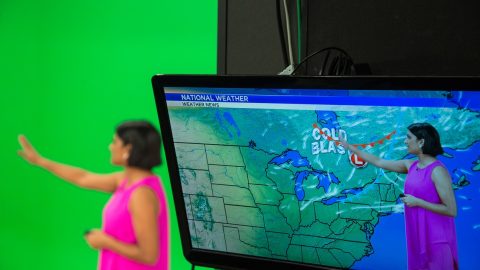
Rosmarie De Witt, ZAMG
Google ‚forecasting future‘, and over 28 million hits appear. Clearly, knowing what will happen before it happens is big business: from financial markets to the weather, and anything in between, says Rosmarie de Wit, Austrian center for meteorology (ZAMG).
In many cases this is more than just curiosity, as this knowledge can be used to optimize decisions and reduce risks by taking precautions. Defensive driving and gritting by highway operators, for example, could prevent accidents in case of predicted frost. To discover parallels between the fields of weather and financial forecasting, a short overview of past and current weather forecasting practices is outlined here.
The wish to predict the weather resulted in all kinds of interesting approaches. A very creative one is the method in which a frog is put in a jar with a little ladder, predicting nice weather if the frog climbs up. Needless to say, an accurate forecast is not guaranteed!
Things improved after the invention of the telegraph in the mid-1800s. Data exchange over large distances became must faster, and the first weather maps with information about the large-scale atmospheric conditions could be drawn.
The realization that the state of the atmosphere can be described using a set of mathematical equations was the next major leap, as it allowed the calculation of future conditions based on the current state of the system. However, it was not until the invention of the first computer in the 1940s that the numerical weather prediction as we know it took off.
Computer simulations
Weather models consist of a system of coupled non-linear partial differential equations, which have to be solved in three spatial dimensions.
These equations can only be solved numerically using computer simulations, and as a result the equations have to be discretized so the calculations can be performed for discrete points in space (on the model grid) and for advancing time.
After initializing the model using observations provided by the global observational network (consisting of e.g. weather stations, satellites, ship and airplane measurements), the situation at future times is determined by calculating the changes occurring during each time step.
In order to account for uncertainties in the initial conditions and approximations in the model physics, several model runs are preformed, each with small tweaks.

Knowing the weather
Smaller deviations, better forecast
Looking at the spread in this model ensemble gives valuable information about the sensitivity of the atmosphere to the initial conditions, and the certainty of the prediction. The smaller the deviations, the more certain one can be the predicted events will happen. The whole forecasting process is computationally expensive, hence supercomputers operate around the clock.
Naturally, forecasts are most reliable for the next few days, but ever increasing computational power and model developments result in continuously improving forecast: today’s 5-day forecast is as accurate as the 3-day forecast was in 2007. So in terms of weather, forecasting the future’ is definitely possible!
Legal note:
Prognoses are no reliable indicator for future performance.
Legal disclaimer
This document is an advertisement. Unless indicated otherwise, source: Erste Asset Management GmbH. The language of communication of the sales offices is German and the languages of communication of the Management Company also include English.
The prospectus for UCITS funds (including any amendments) is prepared and published in accordance with the provisions of the InvFG 2011 as amended. Information for Investors pursuant to § 21 AIFMG is prepared for the alternative investment funds (AIF) administered by Erste Asset Management GmbH pursuant to the provisions of the AIFMG in conjunction with the InvFG 2011.
The currently valid versions of the prospectus, the Information for Investors pursuant to § 21 AIFMG, and the key information document can be found on the website www.erste-am.com under “Mandatory publications” and can be obtained free of charge by interested investors at the offices of the Management Company and at the offices of the depositary bank. The exact date of the most recent publication of the prospectus, the languages in which the fund prospectus or the Information for Investors pursuant to Art 21 AIFMG and the key information document are available, and any other locations where the documents can be obtained are indicated on the website www.erste-am.com. A summary of the investor rights is available in German and English on the website www.erste-am.com/investor-rights and can also be obtained from the Management Company.
The Management Company can decide to suspend the provisions it has taken for the sale of unit certificates in other countries in accordance with the regulatory requirements.
Note: You are about to purchase a product that may be difficult to understand. We recommend that you read the indicated fund documents before making an investment decision. In addition to the locations listed above, you can obtain these documents free of charge at the offices of the referring Sparkassen bank and the offices of Erste Bank der oesterreichischen Sparkassen AG. You can also access these documents electronically at www.erste-am.com.
Our analyses and conclusions are general in nature and do not take into account the individual characteristics of our investors in terms of earnings, taxation, experience and knowledge, investment objective, financial position, capacity for loss, and risk tolerance. Past performance is not a reliable indicator of the future performance of a fund.
Please note: Investments in securities entail risks in addition to the opportunities presented here. The value of units and their earnings can rise and fall. Changes in exchange rates can also have a positive or negative effect on the value of an investment. For this reason, you may receive less than your originally invested amount when you redeem your units. Persons who are interested in purchasing units in investment funds are advised to read the current fund prospectus(es) and the Information for Investors pursuant to § 21 AIFMG, especially the risk notices they contain, before making an investment decision. If the fund currency is different than the investor’s home currency, changes in the relevant exchange rate can positively or negatively influence the value of the investment and the amount of the costs associated with the fund in the home currency.
We are not permitted to directly or indirectly offer, sell, transfer, or deliver this financial product to natural or legal persons whose place of residence or domicile is located in a country where this is legally prohibited. In this case, we may not provide any product information, either.
Please consult the corresponding information in the fund prospectus and the Information for Investors pursuant to § 21 AIFMG for restrictions on the sale of the fund to American or Russian citizens.
It is expressly noted that this communication does not provide any investment recommendations, but only expresses our current market assessment. Thus, this communication is not a substitute for investment advice.
This document does not represent a sales activity of the Management Company and therefore may not be construed as an offer for the purchase or sale of financial or investment instruments.
Erste Asset Management GmbH is affiliated with the Erste Bank and austrian Sparkassen banks.
Please also read the “Information about us and our securities services” published by your bank.


